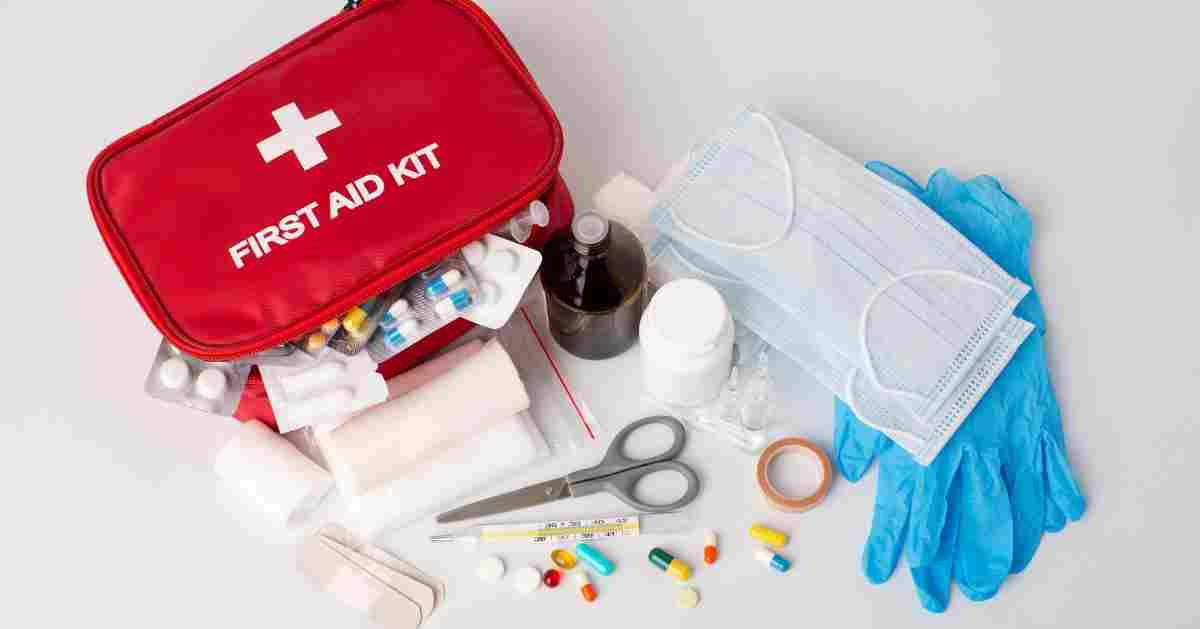Building a Basic First Aid Kit: Step-by-Step Guide

What is in a First Aid Kit?
A first aid kit is a collection of essential medical supplies and equipment designed to provide immediate care for minor injuries and illnesses. Typically, a basic first aid kit includes adhesive bandages of various sizes for covering cuts and scrapes, sterile gauze pads and adhesive tape for dressing larger wounds, antiseptic wipes or solution for wound cleaning, tweezers for removing foreign objects, scissors for cutting tape or clothing, and disposable gloves to prevent contamination.
Additionally, it should contain a CPR face shield or mask for performing CPR safely, instant cold packs to reduce swelling and pain, a thermometer for checking body temperature, and basic pain relievers and antihistamines. Elastic bandages, safety pins, burn cream or gel, adhesive tape, eye wash or saline solution, a first aid manual, and a list of emergency contact numbers are also essential components.
Customization based on specific needs and regular maintenance to check for expired items are important for ensuring the effectiveness of a first aid kit.
A well-prepared first aid kit is a collection of essential medical supplies and equipment, ensuring you’re ready to address minor injuries and medical issues. Here’s a breakdown of the items typically found in a first-aid kit:
Bandages and Dressings:
- Assorted adhesive bandages (such as Band-Aid or similar brands)
- Sterile gauze pads, preferably non-stick
- Eyeshields and pads
- Latex gloves and athletic tape
Ointments and Medications:
- Antibiotic ointments (e.g., bacitracin, polysporin, or mupirocin)
- Antiseptic solution or wipes
- Calamine lotion for stings
- Ibuprofen
- Prescription medicines (if required)
Basic Tools and Health Equipment:
- Blunt-tip scissors
- Mirror
- Tweezers (for removing small splinters or ticks)
- Thermometer
- Razor blade or small knife
Miscellaneous Items:
- Emergency blanket
- Hand sanitiser
- First Aid Manual
- Disposable ice bags
- Sterile cotton balls or cotton-tipped swabs
- Syringes, medicine cups, or medicine spoons
This comprehensive selection of supplies and equipment equips you to administer prompt and effective first aid, whether it’s for a minor injury or a medical issue. Regularly check and replenish the kit to ensure that items remain in good condition and are ready for use when needed.
[Also Read: What Are the Differences Between Air Purifiers and Humidifiers?]
How to Use a First Aid Kit: A Step-by-Step Guide
A well-equipped first-aid kit is an essential resource for dealing with minor injuries and medical emergencies. Knowing how to use it effectively can make a crucial difference in providing immediate care. In this step-by-step guide, we will walk you through the process of using a first-aid kit to assist those in need.
Step 1: Familiarize Yourself with the Kit
Before an emergency arises, take the time to get acquainted with the contents of your first aid kit. Understand the purpose and usage of each item, especially any medications. Ensure that family members or those around you are also familiar with the kit’s contents.
Step 2: Prioritize Safety
Safety is paramount when providing first aid. Before approaching the injured person, assess the surroundings for potential dangers, such as traffic or hazards that caused the injury. Ensure your safety and the safety of others.
Step 3: Call for Professional Help
For severe injuries or life-threatening situations, call 911 or your local emergency number immediately. Professional medical assistance is essential in such cases, and first aid should only be a temporary measure until help arrives.
Step 4: Protect Yourself
When dealing with an injured person, use barrier items like latex gloves from the kit to safeguard yourself from potential contamination. This step is vital to preventing the spread of infections.
Step 5: Assess the Injury or Illness
Carefully evaluate the nature and severity of the injury or illness. Determine whether it requires immediate attention or can be managed with first aid.
Step 6: Apply Basic First Aid
Depending on the situation, use the appropriate items from the first aid kit:
- For cuts, scrapes, and minor wounds, clean the area with antiseptic wipes or solution, then apply adhesive bandages or sterile gauze pads and secure them with adhesive tape.
- For burns, use burn cream or gel on the affected area.
- For sprains and strains, apply an elastic bandage (e.g., an Ace bandage) for support.
- For insect stings or allergies, administer antihistamines if needed.
- For pain or fever, provide over-the-counter pain relievers as directed.
Step 7: Follow First Aid Guidelines
Consult the first aid manual or instruction booklet included in your kit for specific guidance on various injuries or medical conditions. These resources provide step-by-step instructions to assist you in administering appropriate care.
Step 8: Continuously Monitor
While awaiting professional help, if required, closely monitor the injured person’s condition. Be prepared to adjust your first aid measures based on any changes.
Step 9: Document and Report
Keep a record of the care you provide, including the time and any alterations in the individual’s condition. This documentation can be helpful for medical professionals upon their arrival.
Step 10: Restock and Replace
After using items from your first aid kit, replace them promptly and check for expiration dates. Maintaining a well-stocked and up-to-date kit ensures readiness for future emergencies.
Step 11: Seek Professional Care
Remember that first aid is not a substitute for professional medical care. Encourage the injured person to seek medical attention, especially if their condition is severe or deteriorating.
Ensuring Proper Use of Your First Aid Kit
It’s crucial to be well-versed in the correct usage of all items in your first aid kit, particularly medications. Take the time to educate other family members on its contents as well, as you may find yourself in a situation where you require first aid.
Prioritize Personal Protection
When administering first aid, always have barrier items like latex gloves on hand to shield yourself from potential exposure to bodily fluids. Regularly inspect your kit biannually and replace any expired medications to maintain their effectiveness. Additionally, store the phone number of your local poison control centre, which can be found on the American Association of Poison Control Centers website, alongside your first aid kit.
Choosing the Ideal Location for Your First Aid Kit
For easy access during family activities, it’s advisable to keep your first aid kit in the kitchen, where most household members congregate. Avoid storing it in the bathroom due to its high humidity, which can shorten the shelf life of the kit’s contents.
A Travel-Ready Kit
For trips away from home, a designated travel first aid kit is essential. Depending on your activity, store it in a suitcase, backpack, or dry bag, ensuring you have it readily available when needed.
On-the-Go First Aid
Consider maintaining a first aid kit in your vehicle that mirrors the contents of your home kit. You might also consider replicating these kits for your boat (protected within a waterproof bag), travel trailer, mobile home, camper, cabin, vacation home, and any other location where you frequently spend time. This preparedness ensures you have the necessary supplies, no matter where you are.
First Aid Kits for the Workplace: Ensuring Employee Safety
First aid kits in the workplace are essential for ensuring the health and safety of employees. They provide immediate access to medical supplies and equipment necessary for addressing minor injuries and illnesses that can occur on the job. Here’s a comprehensive guide to setting up and maintaining first aid kits in the workplace:
1. Legal Requirements and Regulations
Before assembling or maintaining workplace first aid kits, it’s crucial to understand and comply with local, state, and federal regulations regarding workplace safety. Occupational Safety and Health Administration (OSHA) regulations in the United States, for example, outline specific requirements for first aid kits based on the type of industry and the number of employees.
2. Assessing Workplace Risks
Conduct a thorough assessment of your workplace to identify potential hazards and risks. Consider the nature of the work, the machinery and equipment used, the chemicals present, and any specific injuries or illnesses that employees may be exposed to. This assessment will help you determine the type and size of first aid kits needed.
3. Selecting Appropriate First Aid Kits
Based on the workplace assessment, choose the appropriate type of first aid kit. OSHA recommends three types:
Class A Kit: Suitable for most common workplace injuries, including cuts, scrapes, burns, and minor eye injuries.
Class B Kit: Designed for workplaces with a higher risk of eye injuries. It includes items for irrigating and covering eye injuries.
Class C Kit: For workplaces where employees may be exposed to chemicals. It includes items for decontaminating and treating chemical exposures.
4. Stocking the First Aid Kits
Ensure that the first aid kits are properly stocked with the necessary supplies. Common items in workplace first aid kits may include:
- Adhesive bandages of various sizes
- Sterile gauze pads and adhesive tape
- Antiseptic wipes or solution
- Tweezers and scissors
- Disposable gloves
- CPR face shield or mask
- Instant cold packs
- Thermometer
- Pain relievers and antihistamines
- Elastic bandage (e.g., Ace bandage)
- Burn cream or gel
- Eyewash or saline solution
- First aid manual or instruction booklet
- Emergency contact numbers
5. Placement of First Aid Kits
Ensure that first aid kits are easily accessible and strategically placed throughout the workplace. They should be in locations where employees can quickly reach them in case of an emergency. Common locations include break rooms, kitchens, manufacturing areas, and near machinery or workstations.
6. Training and Education
Provide training to employees on the location of first aid kits, their contents, and basic first aid procedures. Encourage employees to report any incidents or injuries promptly.
7. Regular Inspections and Maintenance
Designate a responsible person or team to conduct regular inspections of the first aid kits. Check for expired items and replace them promptly. Ensure that the kits are always in good condition and ready for use.
8. Emergency Response Plan
Incorporate the use of first aid kits into your workplace’s emergency response plan. Ensure that employees know what to do in case of an injury or medical emergency, including how to access and use the first aid kits.
[Also Read: 5 exercises for lower back pain]
Conclusion
A well-prepared and well-used first aid kit can be a lifesaver in times of need. Following this step-by-step guide and focusing on safety and preparedness, you can confidently provide initial care until professional help arrives. Continuous training and practice are key to mastering first aid techniques and ensuring you are always ready to respond effectively to emergencies.






